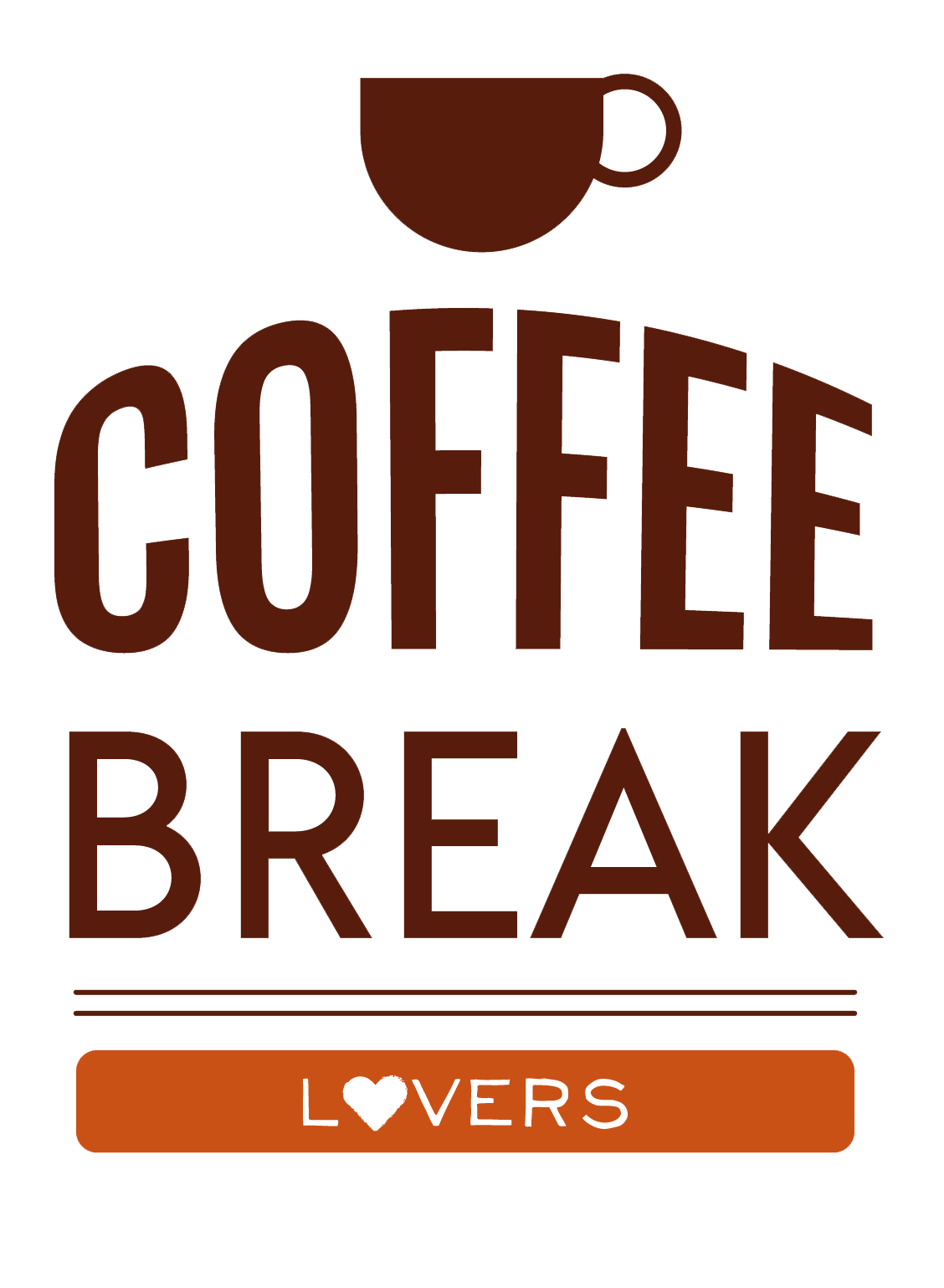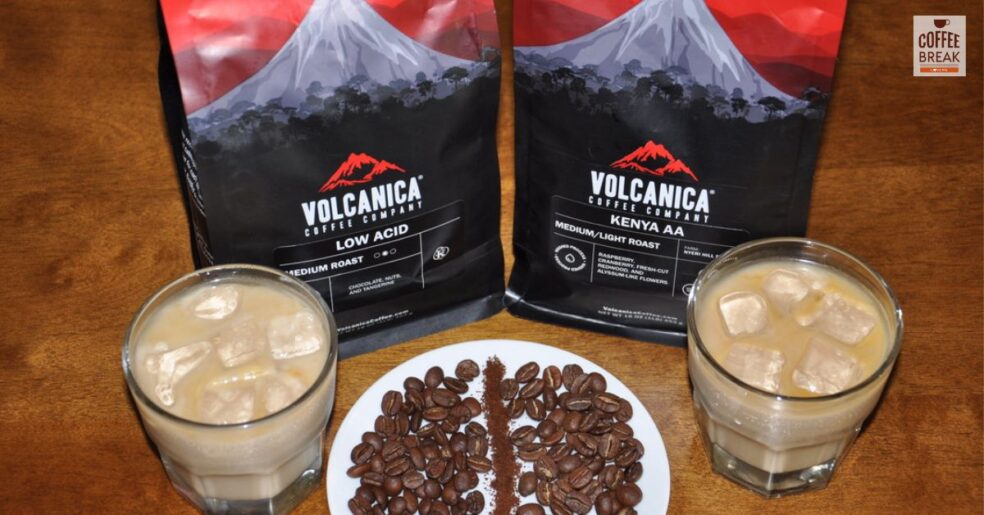Many people like to add milk to their cold brew coffee to enhance its flavor and texture. But rather than adding milk afterward, can you make cold brew coffee with milk instead of water?
In general, you can use milk instead of water to make cold brew coffee. Milk has no problem extracting coffee solubles, and it can even extract coffee oils much easier than water. In addition, milk’s sugar content reduces coffee’s bitterness and results in a sweeter and creamier cold brew coffee.
While using milk has some benefits that water doesn’t, there are some things you’ll need to look out for as well.
To learn more about the benefits and drawbacks of using milk to make cold brew coffee, keep reading!
Can You Make Cold Brew Coffee With Milk?
As a general rule, you can make cold brew coffee with milk.
In fact, I personally prefer making cold brew coffee with milk instead of water because of the improved taste and texture. (We’ll talk more about the taste below).
However, there are a few things you should keep in mind when brewing with milk.
- Milk-based cold brews should not be left on the counter
- You may want to reduce your brewing ratio if you’re using milk
- You may want to adjust your brewing time to make the cold brew less intense
Let’s quickly talk about each one of these.
Don’t Leave Your Milk Cold Brew On The Counter
When using water, cold brew coffee can either be brewed at room temperature or in the fridge. Either way, the coffee will come out just fine.
But unlike water, milk can spoil if left out at room temperature. And since cold brew needs to brew for hours, you definitely don’t want to leave it out on the counter.
If you’re making a cold brew with milk instead of water, make sure you brew it in the fridge.
You May Want To Adjust Your Brewing Ratio
Most water-based cold brews are coffee concentrates. So, they have to be diluted with additional water before you try to drink them.
If you take the recipe for a coffee concentrate and simply use milk, you’ll end up making a milk-based concentrate. While this is perfectly fine if that’s what you want, there are two things to keep in mind:
- If you don’t have extra milk in the fridge, you won’t be able to dilute your coffee concentrate until you make a trip to the store.
- Since milk spoils, your coffee concentrate may go bad before you can drink it all relatively quickly.
To avoid these issues, consider making an unconcentrated cold brew. (We’ll talk more about this later.)
Consider Adjusting Your Brewing Time
Normally, cold brew is brewed anywhere from 12 to 18 hours. But when making it with milk, you may want to adjust your brewing time.
Milk can extract coffee oils much quicker than water can, so the flavor of your cold brew could become intense more quickly than with water. This is why we recommend experimenting with the brewing time until you find the perfect extraction level for you.
Personally, I’ve made cold brew with milk a few times and I’ve found that 16 hours works best.

What Happened When We Brewed Cold Brew Coffee With Milk
We’re big fans of Ethiopian and Kenyan coffees but they are very acidic. So, to experience our favorite coffees with reduced acidity we used them to make several batches of cold brew.
And not just cold brew with water, but milk-based cold brews as well.
Here’s what we used:
- Kenyan, Ethiopian, and Low-acid coffee beans of various roast levels
- Regular whole milk, lactose-free milk, and oat milk
- We ground our beans to a coarse size using our Mr. Coffee grinder
- We brewed our cold brews in a Mueller French Press or Mason Jar.
Each coffee was brewed for about 16 hours and the coffee to milk ratio we used was 1:15. (Two heaping tablespoons of coffee for every half liter of milk.)
Here’s a summary of our results.
| Coffee Beans/ (Roast Level) | Milk | Flavor |
| Volcanica Kenya AA (medium/light roast) | Organic Valley Whole Milk | Bright, and slightly fruity with chocolaty undertones. Milk made the coffee creamy and smooth. |
| Volcanica Low Acid (medium roast) | Lactaid | Smooth, rich, and chocolaty. Milk was creamy and not noticeably different from regular milk |
| Volcanica Ethiopian Yirgacheffe (medium/light roast) | Silk Oat Milk | Bright, and slightly fruity with chocolaty undertones. The coffee’s flavor was dominant so the flavor of the milk was not noticeable. |
| Cooper’s Kenya AA (medium/dark roast) | Lactaid | Deep caramel and chocolate notes with slightly fruity tones. |
How Does Cold Brew Coffee With Milk Taste?
In general, cold brew coffee made with milk is sweeter and creamier than cold brew made with water. And personally, I think they taste similar to the milk-based coffee drinks you can buy at Starbucks.
But the exact flavor of your cold brew will depend largely on two factors
- the type of coffee beans you use and
- the type of milk you use
Let’s take a quick look at each of these factors.
Related Posts:
- How Many TBSP Of Coffee Per Cup? Here’s How To Get It Right!
- Pour Over Vs Drip: Which Is The Best Brew?
Your Choice Of Coffee Will Affect The Cold Brew’s Flavor
When we made our cold brews with milk, each brew had undertones of chocolate. But the unique flavor of the coffee beans was still easily distinguishable.
Since cold brew coffee doesn’t use hot water, the coffee’s flavors don’t degrade quickly and remain intense.
As a result, your cold brew will not only be flavorful, but it will keep its flavor much longer than hot-brewed coffee.
(If you want to read more about the best coffees for cold brew, check out our post “Best Coffees For Cold Brew“)
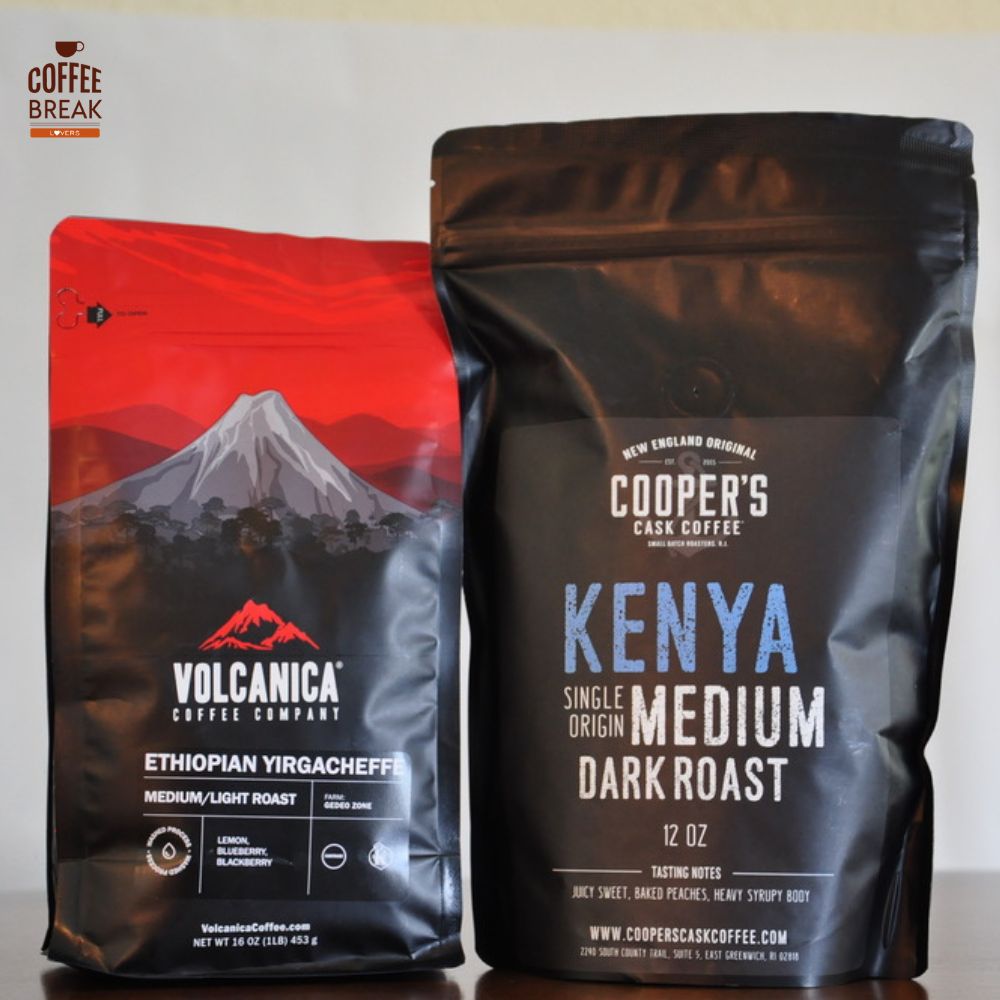
Your Choice Of Milk Will Affect The Cold Brew’s Flavor
You don’t need to make cold brews with regular milk. Any milk will work fine.
But your choice of milk will affect how the cold brew tastes. Since regular milk contains a lot of fats and sugars, it’ll result in a cold brew that’s sweet and creamy even without the addition of extra sugar.
On the other hand, if you use oat, soy milk, or any other type of plant-based milk, the compounds and flavors in the milk will affect your cold brew as well.
In our experience with oat milk, the flavor of the milk is subtle compared to the flavor of the coffee. So, there wasn’t a huge difference between using regular milk and oat milk. But, of course, this is a matter of taste.
How To Make Cold Brew Coffee With Milk?
You’ll need the following:
- A container to hold the coffee
- coffee beans (ground coarsely)
- your preferred milk
- space in your refrigerator
This cold brew recipe uses a coffee-to-milk ratio of 1 to 15. (Or 2 heaping tablespoons of ground coffee for every half liter of milk.)
By using this ratio you won’t get a concentrate. Instead, you’ll get a flavorful, but non-concentrated cold brew coffee.
Step 1: Grind your coffee beans on the coarse setting
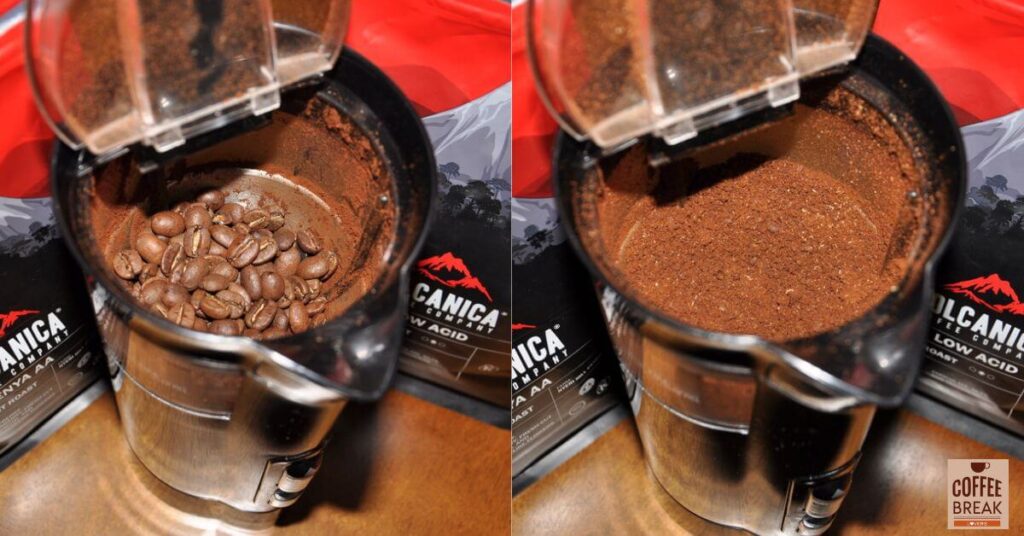
Step 2: Add a portion of the milk and all of the coffee grounds to your container
Step 3: Stir the coffee and milk together and pour in the remaining milk
Step 4: Place the container in the fridge for 16 hours
Step 5: Remove from the fridge and strain out the coffee grinds
Step 6: Serve and enjoy!
Related Post:
- How Long Does An Unopened Cold Brew Last? Safety Tips
- Why is My French Press Hard To Press? ( 5 Tops Reasons!)
- Can I drink Leftover Moka Coffee? (And How To Do It Safely!)
- Moka pot Strenght. (How Strong Will My Brew Be?)
Best Containers To Make Milk-Based Cold Brew Coffee
There are a few different containers to choose from when making cold brew coffee with milk.
For example, you could use a Mason Jar, French Press, or a dedicated appliance such as the Takeya Cold Brew Maker. (Each of these items is available on Amazon)
But each one of these devices has pros and cons to go along with it.
Let’s quickly discuss each of them to see which is best for you.
Mason Jars To Make Cold Brew
A mason jar is the most basic container you can get to make cold brew coffee. It can make cold brew perfectly well, but there’s no easy way to filter the coffee grinds out of the brewed coffee.
Many people recommend using a cheesecloth to strain out the grinds, but the most successful option I’ve found is to use a strainer. (If you don’t have a strainer, you can out Cuisinart’s Mesh Strainers on Amazon.)
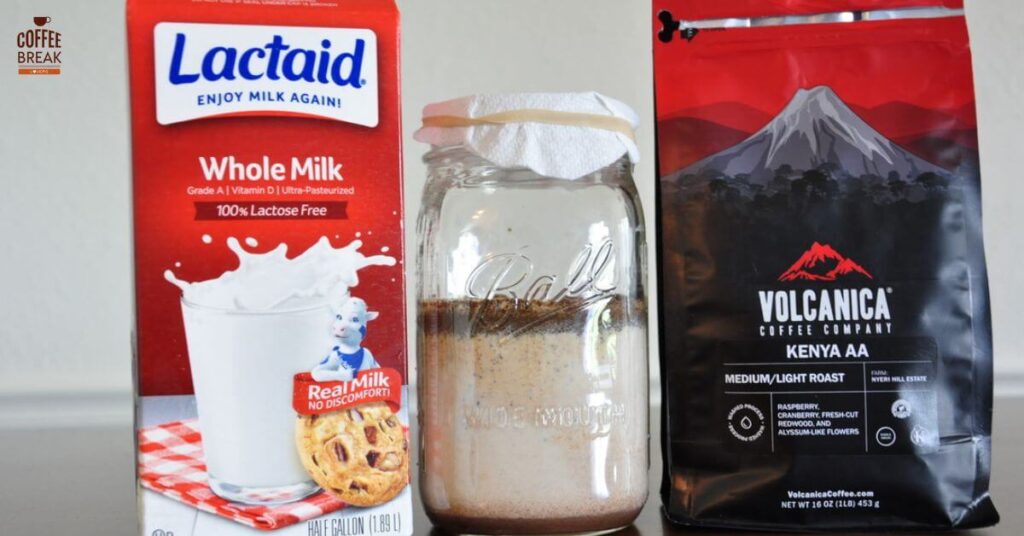
French Presses Can Make Cold Brew
The French Press is another method I’ve frequently used to make cold brew coffee. It works great and I can easily strain out the coffee grinds using the plunger.
However, there are three main issues I’ve had using a French Press to make cold brew with milk.
- Because milk is thicker than water, it can be difficult to press the plunger down (and I don’t want to break the coffee maker by pressing too hard)
- Anytime I’m using my French Press to make cold brew, I can’t use it to brew actual French Press coffee.
- French Presses tend to be small, so the average press can’t make a lot of cold brew at one time.
(I personally have a 34oz Mueller French Press. which is a bit larger than average. If you want to check it out, it’s available on Amazon.)
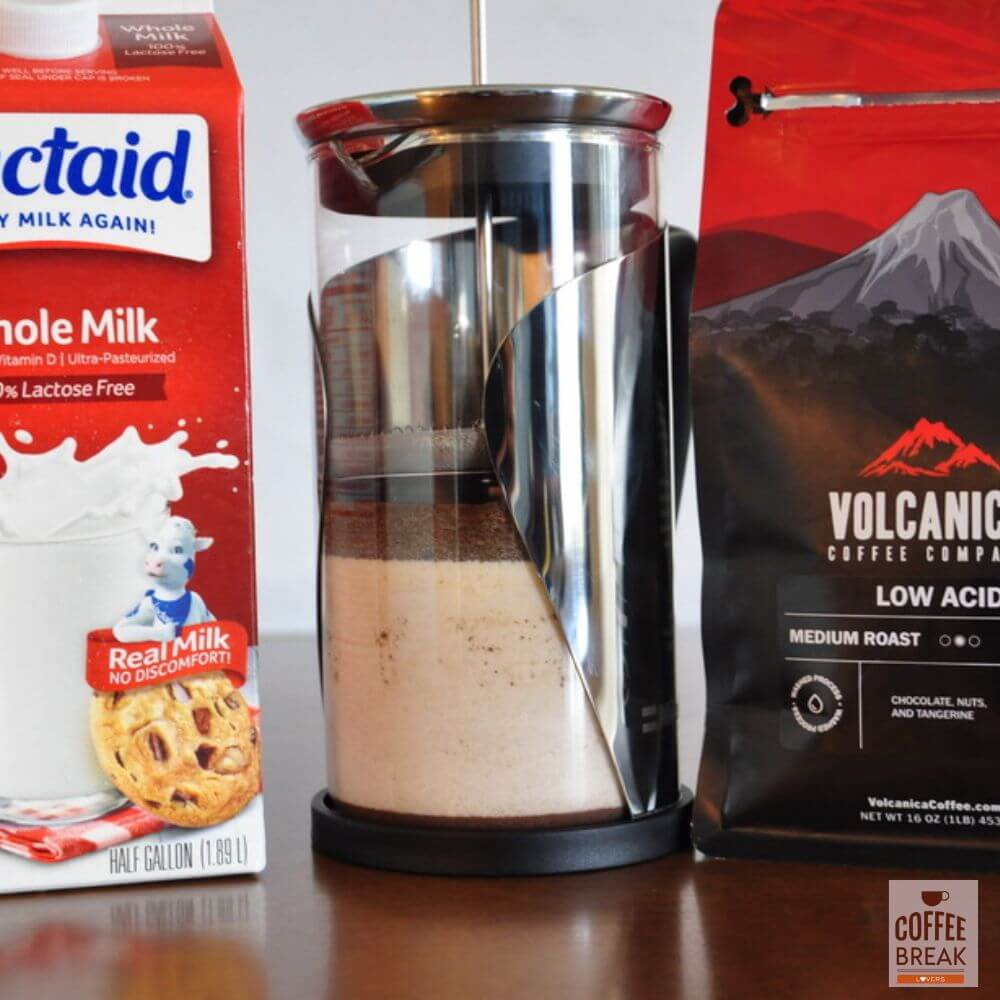
Use Cold Brew Coffee Makers
There are many different types of cold brew coffee makers on the market, and some can work with milk.
One such brewer you can check out on Amazon is the Takeya Cold Brew Maker. With this device, your coffee grinds are held in a fine, mesh filter, and the filter is submerged in the liquid.
So, removing the grinds from your coffee is as simple as removing the filter.
It’s a great option if you don’t want to deal with straining out coffee grinds yourself or occupying your French Press for hours at a time.
Key Takeaways
- Cold brew coffee can be made with milk
- You should store milk-based cold brews in the fridge to prevent spoilage
- Milk extracts coffee oils faster than water, so consider adjusting your brewing time
- Most water-based cold brews are coffee concentrates, so consider adjusting your brewing ratio if using milk
- The flavor of your milk-based cold brew depends on the coffee beans and milk you use.
Cheers Coffee Lovers!

KEEP READING
- Is Arabica Or Robusta Best For Cold Brew Coffee?
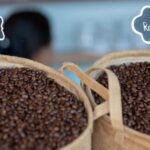
- Why Is My Espresso Puck Wet? (The 6 Most Common Reasons)

- How To Make Cuban Coffee Without A Moka Pot? (3 Options!)

- Does Cold Brew Break A Fast? Things To Consider!

- Can I Use Coffee Grounds Twice? (Here Are Our Results!)
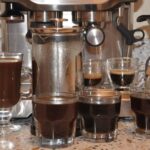
- What’s The Best Grind Size For A Moka Pot? Ultimate Guide!


Idalmis is co-owner of Coffee Break Lovers. She is a Cuban coffee enthusiast that is passionate about coffee and coffee culture.
